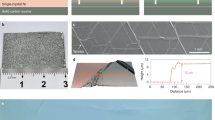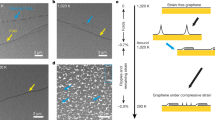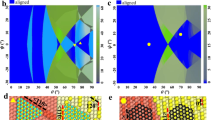Abstract
Wafer-scale single-crystalline graphene monolayers are highly sought after as an ideal platform for electronic and other applications1,2,3. At present, state-of-the-art growth methods based on chemical vapour deposition allow the synthesis of one-centimetre-sized single-crystalline graphene domains in ∼12 h, by suppressing nucleation events on the growth substrate4. Here we demonstrate an efficient strategy for achieving large-area single-crystalline graphene by letting a single nucleus evolve into a monolayer at a fast rate. By locally feeding carbon precursors to a desired position of a substrate composed of an optimized Cu–Ni alloy, we synthesized an ∼1.5-inch-large graphene monolayer in 2.5 h. Localized feeding induces the formation of a single nucleus on the entire substrate, and the optimized alloy activates an isothermal segregation mechanism that greatly expedites the growth rate5,6. This approach may also prove effective for the synthesis of wafer-scale single-crystalline monolayers of other two-dimensional materials.
This is a preview of subscription content, access via your institution
Access options
Subscribe to this journal
Receive 12 print issues and online access
$259.00 per year
only $21.58 per issue
Buy this article
- Purchase on Springer Link
- Instant access to full article PDF
Prices may be subject to local taxes which are calculated during checkout




Similar content being viewed by others
References
Novoselov, K. S. et al. Electric field effect in atomically thin carbon films. Science 306, 666–669 (2004).
Zhang, Y. B., Tan, Y. W., Stormer, H. L. & Kim, P. Experimental observation of the quantum Hall effect and Berry’s phase in graphene. Nature 438, 201–204 (2005).
Bae, S. et al. Roll-to-roll production of 30-inch graphene films for transparent electrodes. Nature Nanotech. 5, 574–578 (2010).
Hao, Y. et al. The role of surface oxygen in the growth of large single-crystal graphene on copper. Science 342, 720–723 (2013).
Zhang, Y. et al. Vapor trapping growth of single-crystalline graphene flowers: Synthesis, morphology, and electronic properties. Nano Lett. 12, 2810–2816 (2012).
Zhou, H. et al. Chemical vapor deposition growth of large single crystals of monolayer and bilayer graphene. Nature Commun. 4, 2096 (2013).
Waldmann, D. et al. Bottom-gated epitaxial graphene. Nature Mater. 10, 357–360 (2011).
Liu, Y. et al. Plasmon resonance enhanced multicolor photo detection by graphene. Nature Commun. 2, 579 (2011).
Liao, L. & Duan, X. Graphene for radio frequency electronics. Mater. Today 15, 328–338 (July–August, 2012).
Tsen, A. W. et al. Tailoring electrical transport across grain boundaries in polycrystalline graphene. Science 336, 1143–1146 (2012).
Geng, D. C. et al. Uniform hexagonal graphene flakes and films grown on liquid copper surface. Proc. Natl Acad. Sci. USA 109, 7992–7996 (2012).
Ma, T. et al. Edge-controlled growth and kinetics of single-crystal graphene domains by chemical vapor deposition. Proc. Natl Acad. Sci. USA 110, 20386–20391 (2013).
Yu, Q. K. et al. Control and characterization of individual grains and grain boundaries in graphene grown by chemical vapor deposition. Nature Mater. 10, 443–449 (2011).
Vlassiouk, I. et al. Graphene nucleation density on copper: Fundamental role of background pressure. J. Phys. Chem. C 117, 18919–18926 (2013).
Kim, H. et al. Activation energy paths for graphene nucleation and growth on Cu. ACS Nano 6, 3614–3623 (2012).
Yan, Z., Peng, Z. W. & Tour, J. M. Chemical vapor deposition of graphene single crystals. Acc. Chem. Res. 47, 1327–1337 (2014).
Yan, Z. et al. Toward the synthesis of wafer-scale single-crystal graphene on copper foils. ACS Nano 6, 9110–9117 (2012).
Gao, L. et al. Repeated growth and bubbling transfer of graphene with millimeter-size single-crystal grains using platinum. Nature Commun. 3, 699 (2012).
Lee, J. H. et al. Wafer-scale growth of single-crystal monolayer graphene on reusable hydrogen-terminated germanium. Science 18, 286–289 (2014).
Wang, H. et al. Controllable synthesis of sub millimeter single-crystal monolayer graphene domains on copper foils by suppressing nucleation. J. Am. Chem. Soc. 134, 3627–3630 (2012).
Li, X. et al. Large-area graphene single crystals grown by low-pressure chemical vapor deposition of methane on copper. J. Am. Chem. Soc. 133, 2816–2819 (2011).
Chen, S. et al. Millimeter-size single-crystal graphene by suppressing evaporative loss of Cu during low pressure chemical vapor deposition. Adv. Mater. 25, 2062–2065 (2013).
Wu, T. et al. Triggering the continuous growth of graphene toward millimeter-sized grains. Adv. Funct. Mater. 23, 198–203 (2013).
Yan, Z. et al. Large hexagonal Bi- and trilayer graphene single crystals with varied interlayer rotations. Angew. Chem. Int. Ed. 53, 1565–1569 (2014).
Yu, Q. K. et al. Graphene segregated on Ni surfaces and transferred to insulators. Appl. Phys. Lett. 93, 113103 (2008).
Shante, V. K. S. & Kirkpatrick, S. An introduction to percolation theory. Adv. Phys. 20, 325–357 (1971).
Gannett, W. et al. Boron nitride substrates for high mobility chemical vapor deposited graphene. Appl. Phys. Lett. 98, 242105 (2011).
Petrone, N. et al. Chemical vapor deposition-derived graphene with electrical performance of exfoliated graphene. Nano Lett. 12, 2751–2756 (2012).
Dean, C. R. et al. Boron nitride substrates for high-quality graphene electronics. Nature Nanotech. 5, 722–726 (2010).
Wang, L. et al. One-dimensional electrical contact to a two-dimensional material. Science 342, 614–617 (2013).
Acknowledgements
We thank J. Chen and X. Y. Liu for help with device fabrication. We thank R. Ding and Z. Liang from the Graphene Research and Characterization Center of China for their assistance in thickness verification of our graphene. The work in Shanghai Institute of Microsystem and Information Technology, Chinese Academy of Sciences is partially supported by the National Science and Technology Major Projects of China (Grant No. 2011ZX02707), the External Cooperation Program of the Chinese Academy of Science (Grant No. GJHZ 1306), CAS International Collaboration and Innovation Program on High Mobility Materials Engineering and the National Natural Science Foundation of China (Grant No. 11304337). The work in East China Normal University is supported by an NSFC grant (Grant No. 21303056) and the Shanghai Pujiang Program (13PJ1402600). The computations were performed in the Supercomputer Centre of East China Normal University. Q. Yu thanks K. Sun and H. Chen for discussion.
Author information
Authors and Affiliations
Contributions
X.X. and Q. Yu designed the project. F.D. designed the theoretical part. T.W. realized the nucleation control and inch-sized SCG with X.Z. T.W., X.Z. and G.L. performed the characterizations. Q. Yu proposed the isotope experiments and validated the isothermal segregation mechanism; the isotope growth and Raman mapping were done by J.X. and Z.L. Q. Yuan performed the first-principles calculations together with F.D. Huishan Wang made the devices and carried out transport measurements, and Haomin Wang analysed the transport results. X.X., Q.K.Y. and F.D. co-wrote the manuscript. All of the authors participated in the data analysis, discussions of results and manuscript revisions.
Corresponding authors
Ethics declarations
Competing interests
The authors declare no competing financial interests.
Supplementary information
Supplementary Information
Supplementary Information (PDF 2596 kb)
Supplementary Movie 1
Supplementary Movie 1 (MPG 3474 kb)
Rights and permissions
About this article
Cite this article
Wu, T., Zhang, X., Yuan, Q. et al. Fast growth of inch-sized single-crystalline graphene from a controlled single nucleus on Cu–Ni alloys. Nature Mater 15, 43–47 (2016). https://doi.org/10.1038/nmat4477
Received:
Accepted:
Published:
Issue Date:
DOI: https://doi.org/10.1038/nmat4477
This article is cited by
-
Active machine learning model for the dynamic simulation and growth mechanisms of carbon on metal surface
Nature Communications (2024)
-
Realization of large-area ultraflat chiral blue phosphorene
Nature Communications (2024)
-
Theoretical investigations on the growth of graphene by oxygen-assisted chemical vapor deposition
Nano Research (2024)
-
Vapour-phase deposition of two-dimensional layered chalcogenides
Nature Reviews Materials (2023)
-
Fast scanning growth of high-quality graphene films on Cu foils fueled by dimeric carbon precursor
Nano Research (2023)



